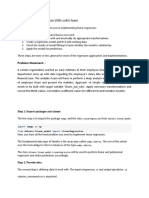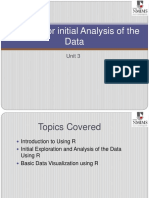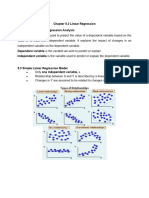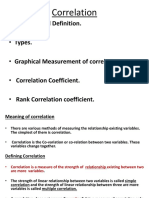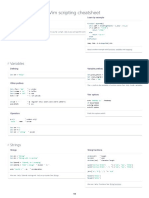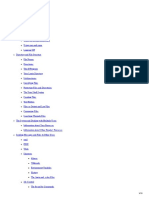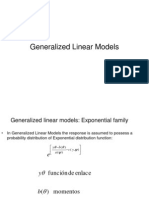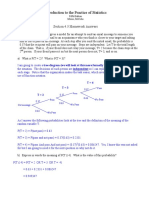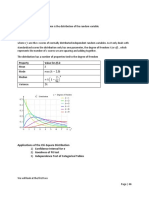Statistics and Data Analytics Cheat Sheets
Uploaded by
Giova RossiStatistics and Data Analytics Cheat Sheets
Uploaded by
Giova Rossi(Cheat Sheet)
Data Types: Helps answer: “Is the sample a fair representation of the population?”
- Attribute Data – Qualitative: Hypotheses:
* Text Data – e.g. yes/no, pass/fail, approve/reject…
- Variable Data – Quantitative: - Null Hypothesis (Ho) – assumes NO differences (the same), p-value > 0.05
* Discrete – counted numbers – e.g. # of defects (74), # of customer returns (13) - Alternative Hypothesis (Ha) – states there is a difference, p-value < 0.05
* Continuous – decimal numbers – e.g. time (12:24:59), money ($17.4354), pressure (25.44534 lbs.)
Tests for Normal Data (“t-tests”):
Types of Statistics:
- 1-Sample t-Test – study one sample’s mean against a target.
- Descriptive Stats – Used to describe and summarize data. - 2-Sample t-Test – study means from two different samples.
- Inferential Stats – Drawing conclusions about a population, when sample data is used. - ANOVA Test – study means from more than two samples.
* As we gather data, we work with samples. - Paired t-Test – study paired data (e.g. same part before/after improvement).
* We need confidence that our sample represents the population.
Normal vs Non-Normal Data
Measures of Central Tendency:
- Hypothesis tests with NORMAL data use the mean for central tendency
- Mean – The average.
- Hypothesis tests with NON-NORMAL data use the median for central tendency
- Median – The middle value.
- Mode – The most frequently occurring value.
- Trimmed Mean – A compromise between the mean and median, removes some outliers then averages.
Measures of Variation:
- Range – Difference between the largest and smallest value.
- Interquartile Range – Difference between the 75th and 25th percentile. - Shows the cause and effect relationship between X and Y.
- Standard Deviation – Average deviation of values from the mean. - Helps determine the proper settings (levels) for our inputs (X) in order to optimize our output (Y).
- Variance – Average squared deviation of values from the mean.
Key Terminology:
Basic Graphs:
- Factors (x) – The independent variables being used (e.g. temperature).
- Histogram – shows central tendency and variation within a single distribution. - Levels – The various settings for the factors (e.g. 300°, 500°).
- Dotplot – similar to a histogram, but shows each value as an individual point. - Run – A set of experimental conditions. (Experiments have multiple.)
- Boxplot – shows central tendency and a variation within several distributions, not just one. - Response (y) – The result from an experimental run (e.g. material strength).
- Time-Series Plot – shows critical quality measurements over time. - Replication – The repetition of experimental runs. (Challenges the result.)
- Scatterplot – shows the relationship between two variables. Common Types of Experiments:
Data Measurement Scales: - Full Factorials – use 2-5 input variables with all combinations of levels (or settings).
- Fractional Factorials – use 4-15 input variables and a fraction of combinations.
- Nominal – Cannot be ordered; no arithmetic can be performed. e.g. city (Detroit, Cleveland, Seattle).
- Ordinal – Can be ordered; differences between values meaningless. e.g. taste (bad, okay, good). General Notation for Full Factorial Design (2k):
- Interval – Can be ordered; differences between values meaningful (not ratios). e.g. temp (0o, 10o , 20o).
- Ratio – Can be ordered; ratios meaningful; zero indicates an absence. e.g. weight (0kg, 25kg, 50kg). - k = # of input variables
- 2 = # of levels used for each factor
Types of Sampling & Measurement Errors:
Principles of Good Experimental Design:
- Sampling Error – Differences among samples drawn at random (“luck of the draw”).
- Randomization of runs to remove bias and spread noise
- Sampling Bias – A lack of random samples (e.g. height of basketball players only).
- Replication of the experiment to challenge or strengthen the validity of results.
- Measurement Error – Issues with our measurement systems.
- Monitoring of noise.
- Measurement Invalidity – Not measuring what it is intended (e.g. temperature near a furnace). - Holding other factors constant. (Those that are not a focus on the experiment.)
(Cheat Sheet)
What is Analytics?
Microsoft Excel
Allows you to explore/analyze smaller data sets
data
business
data
insight Tableau Desktop (or Power BI)
data
Allows you to visualize your data with dashboards
Types of Analytics Python Language (or R)
o Descriptive Analytics What happened? Allows you to build models to make predictions
o Predictive Analytics What might happen?
o Prescriptive Analytics What should we do?
Structured Query Language (SQL)
Lifecycle of Analytics (“CRISP-DM”) Allows you to communicate and interact with databases
o Business Understanding Define the business problem.
o Data Understanding Identify available data and gaps in data.
o Data Preparation Clean and prepare the data.
o Modeling Build predictive models.
o Evaluation Evaluate how the models perform.
o Deployment Start using the chosen model.
Common Job Titles
o Business Analyst
o Business Intel. Analyst
o Analytics Manger
o Data Analyst
Big data is so large that “it requires the use of new technical architectures … o Data Scientist *
to enable insights that unlock new sources of business value.” (McKinsey) o …
* Most people feel this job is more technical.
3 V’s of Big Data (Defining Characteristics)
Most job postings ask about software, so:
o Select a tool from above
o Download a free trial.
o Get a pizza!
o Spend a weekend to learn.
o State you have “Experience with…” on your resume.
Volume Velocity Variety
You might also like
- A Comprehensive Statistics Cheat Sheet For Data Science Interviews - StrataScratchNo ratings yetA Comprehensive Statistics Cheat Sheet For Data Science Interviews - StrataScratch32 pages
- 7 Data Science / Machine Learning Cheat Sheets in One100% (1)7 Data Science / Machine Learning Cheat Sheets in One9 pages
- Test Bank For Introduction To The Practice of Statistics 9th Edition by David S. MooreNo ratings yetTest Bank For Introduction To The Practice of Statistics 9th Edition by David S. Moore19 pages
- Part B Hypothesis Testing and Confidence Intervals100% (1)Part B Hypothesis Testing and Confidence Intervals10 pages
- Dealing With Missing Data in Python Pandas100% (1)Dealing With Missing Data in Python Pandas14 pages
- Unit 6. Ethical Issues in Data Science PDFNo ratings yetUnit 6. Ethical Issues in Data Science PDF19 pages
- A Comprehensive Statistics Cheat Sheet For Data Science 1685659812No ratings yetA Comprehensive Statistics Cheat Sheet For Data Science 168565981239 pages
- Cheatsheet Machine Learning Tips and Tricks PDFNo ratings yetCheatsheet Machine Learning Tips and Tricks PDF2 pages
- Introduction To Data Science MethodologyNo ratings yetIntroduction To Data Science Methodology4 pages
- Data Science: Chapter 1: Introduction To Big Data100% (2)Data Science: Chapter 1: Introduction To Big Data77 pages
- PPT2-W1-S2-R0 - Descriptive Analytics I Statistical ModellingNo ratings yetPPT2-W1-S2-R0 - Descriptive Analytics I Statistical Modelling46 pages
- Introduction To Data Mining With Case Studies - Sample Index0% (1)Introduction To Data Mining With Case Studies - Sample Index16 pages
- Business Analytics (MIS171) Summary NotesNo ratings yetBusiness Analytics (MIS171) Summary Notes6 pages
- Phase Transition Extraction Using Solvent Mixtures With Critical Point of MiscibilityNo ratings yetPhase Transition Extraction Using Solvent Mixtures With Critical Point of Miscibility13 pages
- Mathematical Modeling of Photochemical Air PollutionNo ratings yetMathematical Modeling of Photochemical Air Pollution29 pages
- Chapter 6 - Random Variables and Probability DistributionsNo ratings yetChapter 6 - Random Variables and Probability Distributions101 pages
- Statistics and Probability USLeM Q3 Week 3No ratings yetStatistics and Probability USLeM Q3 Week 310 pages
- Mann Whitney Test - 20240530 - 013144 - 0000No ratings yetMann Whitney Test - 20240530 - 013144 - 000024 pages
- Introduction To The Practice of Statistics: Section 4.3 Homework AnswersNo ratings yetIntroduction To The Practice of Statistics: Section 4.3 Homework Answers7 pages
- Binder-7-Intro To Data Vis With SeabornNo ratings yetBinder-7-Intro To Data Vis With Seaborn150 pages
- FRM Quantitative Analysis Test 1 SolutionsNo ratings yetFRM Quantitative Analysis Test 1 Solutions4 pages
- Computer Vision: Models, Learning and InferenceNo ratings yetComputer Vision: Models, Learning and Inference59 pages
- Basic Probability: Business Statistics, A First Course (4e) © 2008 Pearson Education Chap 4-1No ratings yetBasic Probability: Business Statistics, A First Course (4e) © 2008 Pearson Education Chap 4-136 pages






























